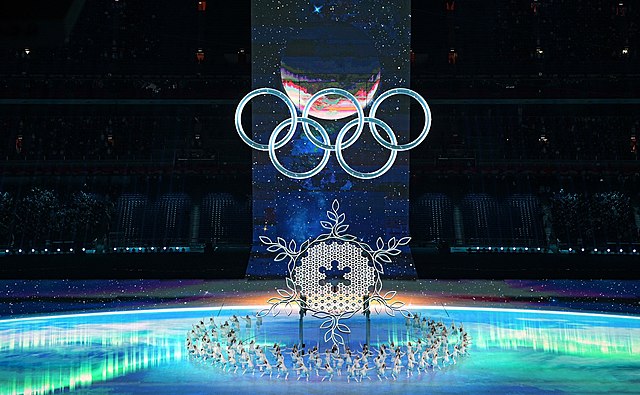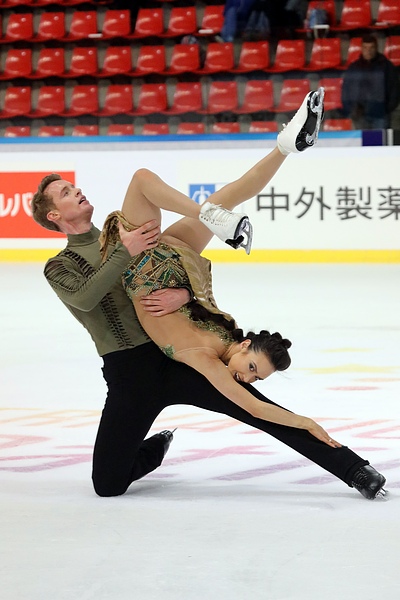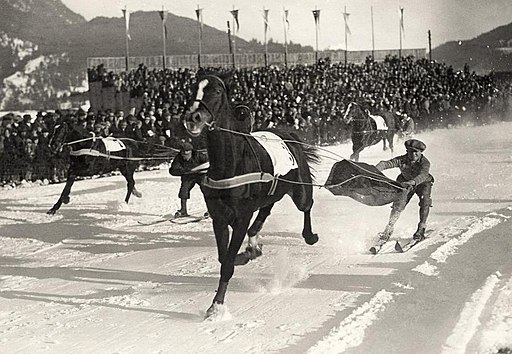
CC BY-4.0, via Wikimedia
The 2022 Winter Olympic Games in Beijing wraps up today. Over the past two weeks, we’ve watched athletes and teams from 91 nations skate, ski, and sleigh their way to Olympic glory (including 25 medals for Team USA!) and learned plenty of new words in the process. Here, our nine favorite Winter Olympics terms and their origins:
Twizzle
Unlike spins, which are stationary, twizzles require rotation while moving across the ice. The synchronized twizzle is one of the most fundamental, and difficult, parts of ice dancing, and definitely the most fun to say.
Kiss & Cry
The term kiss & cry was coined by Finnish figure skating official Jane Erkko, who popularized the sport in Finland in the 1980s. It’s since been expanded to other sporting events to mean any area where competitors wait to receive their scores.
Death Spirals
Unlike in aviation, insurance, or life in general, death spirals in figure skating can—if executed correctly—be a good thing. The death spiral is an element of pairs figure skating in which the man, in a low pivot position, rotates the woman low to the ice. The name was apparently inspired by the popularity of air show stunts in the 1920s.

CC BY-SA 3.0. By David Carmichael, via Wikimedia
Axel
The axel, one of the seven types of jump in figure skating, has nothing to do with the type of axle around which a wheel rotates; it’s actually an eponym, named after Norwegian figure skater Axel Paulsen.
Bobsled
Bobsledding, or Bobsleigh, has been a part of the winter Olympic games since their inception in 1924. Unlike with axel, there is no eponymous “Bob”: the sport gets its name from the way early participants bobbed back and forth to increase speed.
Monobob
Bobsledding is traditionally performed with teams of either two or four. A one-person bobsled is charmingly deemed a monobob, which is also the name of the newest Winter Olympic sport. Women’s monobob debuted at the 2022 Olympics, where Americans Kaillie Humphreys and Elana Meyers Taylor took the gold and silver, respectively.
Skeleton
Skeleton involves going headfirst down an ice track on a sled, unlike its sister sport luge, where competitors go feet first. The term skeleton is of uncertain origin: some say it takes its name from the bony appearance of the early metal sleds, while others think it might be a mistransliteration of the Norwegian word kjaelke, meaning toboggan or sled.
Hog line
Watch a game of curling, and you’ll notice a lot of hog terminology: the hog line is the line by which players have to release the stone. If a rock is hogged, it’s taken out of play. Since the early 2000s, hog line violations have been enforced by an electronic sensor called “eye on the hog.”
Why all the porcine language? According to curling.ca, the phrase derives from Scottish agriculture, where straggling baby lambs and other livestock were called hogs.
Skijoring
From 1912 to 1992, Olympic Games included demonstration sports: non-medal events meant to popularize new or underappreciated sports with the goal of their eventual inclusion in the Olympics. Some sports, like ice dancing, speed skating, and curling, became full-fledged Winter Olympic events.
One that didn’t is skijoring, a sport that involves skiers being drawn over ice by dogs, vehicles, or—in the case of the Olympic demonstration—horses. Skijoring, which has its roots in Scandinavia, debuted at the 1928 Winter games in St. Moritz, but never returned as a demonstration or medal sport.

Public Domain, via Wikimedia
Got a favorite winter sports word that we missed? Let us know on Twitter!